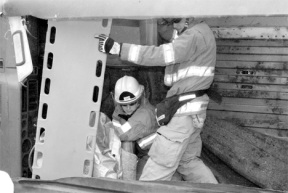FREELAND — The crunch of metal is horrendous and the smell of fuel fills the air.
No, it’s not the aftermath of demolition derby, but a rollover accident involving one or more cars, injuries to drivers and passengers.
Or is it?
Six firefighters from Fire District 3 gathered at Island Recycling recently to hone their skills as automobile extrication experts. The men have all volunteered to be point men in safely removing trapped victims during automobile accidents.
Once a month, usually the first Sunday of the month, the firefighters take their extrication tools and wait for the accident to “happen.” On a recent weekend, a 2.5-ton Dodge van was tipped over onto its side by a forklift to simulate a rollover accident followed by a pick-up truck slamming into the van’s roof.
A traffic cone was used to sit in as an injured “victim,” and the team assessed how best to get inside the van and get the driver out.
The practice has paid dividends to the team. They recently returned from South Carolina where they competed with and learned lessons from 30 other national teams at the 2007 Transportation Emergency Rescue Committee, National Extrication Challenge.
The contest, called TERC for short, is only a part of the deal at symposiums like this, said Paul Hunsaker, the incident commander for the Fire District 3 TERC team.
“The main purpose of it is to learn and to teach. We go to these symposiums and we learn about new technologies, new tools, new techniques and the new cars. It is constantly evolving,” Hunsaker said.
“These guys are top of their field, cutting edge auto-extrication guys who teach classes. It is that learning element that is huge throughout it,” he explained.
Lighter and more fuel efficient cars that are stuffed with a lot of new technologies have forced firefighters to adapt their extrication techniques, said Peter Williams, a team member and an automobile mechanic.
“They are making new cars every year. There are more restraints in them, more explosives, sheet metal is getting thinner,” he said. “It is getting harder to use the jaws of life on them. The sheet metal tears instead of crumbles. So we have to reverse to using the electric tools, reciprocating saw and air chisel on some of the newer cars.”
Firefighters are finding they need to be extra cautious around these newer vehicles as well, Hunsaker said.
“Side impact air bags can act like a guillotine, and if a rescuer reaches and adds a little weight to the patient while they are feeling them to make sure they are not bleeding, that thing goes off and it’s dangerous,” Hunsaker said.
“You have stuff that can blow up on you, pressurized little cylinders and when you’re cutting into it, boom! There is your patient’s face right there. It is a totally different ball game,” he said.
As the team gains knowledge and experience, they apply it to the real-world accidents that occur on the many miles of roads that stretch across the district’s coverage area. Team members also share the tricks they’ve learned with the rest of the fire district, said Capt. Frank Mestemacher.
“We are usually split up,” he said. “Hunsaker may be on a call and I am on another call and whoever I have there, I can pretty much tell have worked with tools before because I have probably trained them and worked with them in the past,” he said.
The team did so well in South Carolina, they were invited to attend the 2007 International Extrication Challenge, to be held later this month in Indianapolis, Ind.
Because the competition is coming so soon, however, the team might not have enough time to raise funds and go.
“It just blows our minds like we can’t even imagine that our little department is getting invited. We’ve all decided we want to do it but we’re just trying to figure out if it is possible,” Hunsaker said.
However, the team remains thankful to the people who made it possible for them to go to the nationals.
“We could not have done this without the support of the community,” said team member Bryce Lyshol. “The contributions from the public covered our travel expenses, hotel and airfare.”
Fire District 3 TERC team members also include Peter Williams, Eric Unke and Jon Gabelein.



